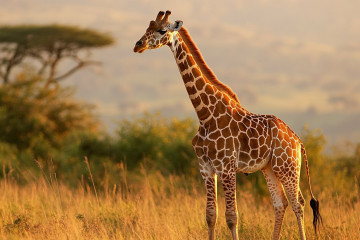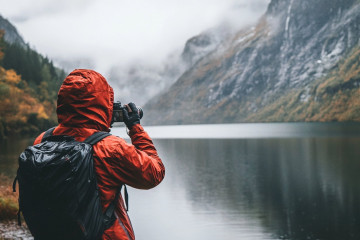As crowds grow and parks reach capacity, responsible national-park travel is more important than ever. Here’s how to leave a lighter footprint, according to rangers.
Most of us don’t set out to be irresponsible visitors in national parks. We adhere to Leave No Trace (LNT) principles and view roped-off sections as no-go zones—not barriers between us and the perfect photo op.
But then we bend the rules with a quick off-path shortcut between our congested trail and the less trodden one. Or nature calls at the most inopportune moment, on the rare day we forgot bags to pack out used toilet paper. “Just this once,” we tell ourselves, resting assured we follow LNT 99 percent of the time.
But with bigger crowds and first-time visitors modeling other travelers’ behaviors, even small just-this-once choices can add up. “Are more people behaving badly? Probably not. Most of our visitors are behaving well. They’re doing the right thing,” says Kyle Patterson, public affairs officer for Rocky Mountain National Park. “It’s just that we have more people.”
To help you simultaneously enjoy and protect America’s beloved outdoor spaces, we gathered important reminders from rangers and tour outfitters who see these park problems firsthand. Here’s how they suggest visiting national parks responsibly.
Don’t skimp on preparation
With more parks requiring permits and reservations, it’s getting tougher to visit spontaneously—and according to Patterson, that’s not all bad. She says park research and preparation are key; without them, you’re putting yourself at risk (and potentially monopolizing search-and-rescue resources).
“You might be a really fit person, but fitness really doesn’t matter when it comes to feeling the ill effects of higher elevations,” Patterson says, recommending visitors from lower elevations give their bodies time to adjust to RMNP, which ranges in elevation from 7,860 to 14,259 feet. (This kind of adjustment typically requires a day or two, according to the Cleveland Clinic.)
Planning also involves checking the weather forecast. In some parts of the country, spring means sunshine and blooming flowers, but “we get most of our snow in March and April,” says Patterson, noting visitors often show up without gear fit for the elements.
Being prepared for all conditions—from a quick change in weather to the ill effects of altitude—does more than keep you comfortable while exploring. It helps preserve the NPS’s search-and-rescue resources, which are stretched thin. Beyond fitness, altitude, and weather preparation, take additional precautions like carrying a satellite phone and a paper map, and let a responsible friend or family member know your route, especially if you’re hiking the backcountry.
Adjust your expectations—or visit in the off-season
National parks are crowded, and that’s not changing anytime soon. Sure, timed entries may ease the burden, but “if you’re planning on going [to a national park] between Memorial Day and mid-October, in the middle of the day, you should expect there are going to be a fair number of people,” says Chip Jenkins, superintendent of Grand Teton National Park, one of many parks that struggled with overcrowding during the pandemic.
Jenkins suggests visiting in the off-season or off-hours. “You can have a fabulous time by visiting these places in the evening, at night, and in the early morning, when you’ll largely have these places to yourself.”
If you do visit during busy times, be kind to fellow travelers. And remember you, also, are part of the crowd. “National parks belong to all of us,” Patterson says. “Visitors who’ve been coming for years and visitors who are coming for the first time are all important because these are the people that will be stewards of this place.”
Don’t DIY a parking spot
Unprecedented crowds mean limited parking spots. Patterson says she’s seen a growing number of drivers creating their own spots so they can get out and enjoy the park sooner—a move that damages native flora.
“Don’t create parking spaces where there are none,” she says, acknowledging that this may mean waiting in your car longer to find a spot. “Park in designated spaces, on asphalt and gravel, not on grass, meadows, bushes, or alpine tundra.”
Respect wildlife
It’s not about how close you can get to a wild animal, such as a bobcat, coyote, or bear, says Patterson. You should be asking the reverse: “How far should I stay back?”
And yes, this applies to animals that look cute and cuddly—or those that would make for a great photo. “What people do is they keep approaching and approaching until the wildlife starts to react to their presence,” says Patterson. But in an instant, this wildlife encounter can turn tragic—as in the 2019 bison attack, seen in a viral video, that required the airlifting of a young girl out of Yellowstone National Park.
At Yellowstone, where wildlife encounters happen almost daily, rangers ask visitors to keep a distance of at least 25 yards from bison and elk, and 100 yards from bears and wolves, according to Wyoming Public Radio.
Follow local campfire rules
Given the ever growing wildfire risk, particularly out west, rangers urge visitors to learn and follow all campfire guidelines. “Rocky always has fire restrictions in place,” says Patterson, noting that RMNP restricts campfires except in designated campfire rings in picnic areas and campgrounds in the front country.
Whether it’s a RMNP picnic area or any outdoor area that allows campfires, it’s important to follow Leave No Trace fire guidelines, including using water (not dirt) to put out a fire and packing out all campfire litter.
Learn local Indigenous history
Sweeping vistas and snowcapped mountains may dazzle, but many U.S. national parks have deep Indigenous histories. Understanding a park’s past and learning about local Indigenous experiences are integral to becoming a responsible national-park traveler.
“We like to seek perspectives from the community and learn how history is perceived through different lenses,” says Matt Berna, a general manager for Intrepid Travel, a B Corp certified travel outfitter that’s been running national-park tours for over 20 years. Intrepid coordinates trips to reservations with Indigenous guides to “highlight the original stewards of the land and pay respect to their history by learning their stories.”
You can coordinate cultural trips of your own with a bit of planning and research. “Many reservations have cultural tourism. The Wind River Reservation, one of the closest to Grand Teton, has an extensive series of recommendations and ideas for visitors,” Jenkins says. “That’s true all over the country, from Florida, the Dakotas, and Washington State to California and Texas.”
Be bathroom-wise
One less than pleasant by-product of increased national-park crowds: increased human waste. “Every day, [trail crews] go to move a rock, and there’s human waste,” Patterson says. “Or they go to move something else, and there’s toilet paper spread all over the place.”
When you can, use established restroom facilities, says Patterson. And if you’re out hiking and can’t hold it, know the two important practices Intrepid’s LNT-certified guides teach their guests: “Keep at least 100 yards away from watercourses for toilet stops,” Berna says, “and bury waste at least six inches below the surface.”
Observe pet restrictions
We all love our trail dogs, but parents of even the best-trained pups need to follow the rules. “We continue to see people who come here with dogs walking past signs that say dogs prohibited,” says Patterson.
“That’s extremely unfortunate because dogs are predators, they can transmit diseases to wildlife, and they can become prey to wildlife,” she says. “Other visitors should be able to enjoy native wildlife in their natural environment, without disruption from other visitors’ pets.” At RMNP, leashed dogs are allowed only in front-country campgrounds or roads, not on trails.
Stick to the trail
Sure, some destinations, like Denali National Park, allow off-trail hiking—but you should go off-trail only if the park explicitly allows it. Patterson says sticking to the marked trails is one of the best ways to protect these national parks for the future.
“The increase of social trails [informal trails created by foot traffic] is damaging the park’s resources,” she says. “Don’t [take a] shortcut; don’t widen the trail by stepping off. That’s something that’s obviously happened for decades, but when you have more and more people doing it, you’re going to see more impacts.”


